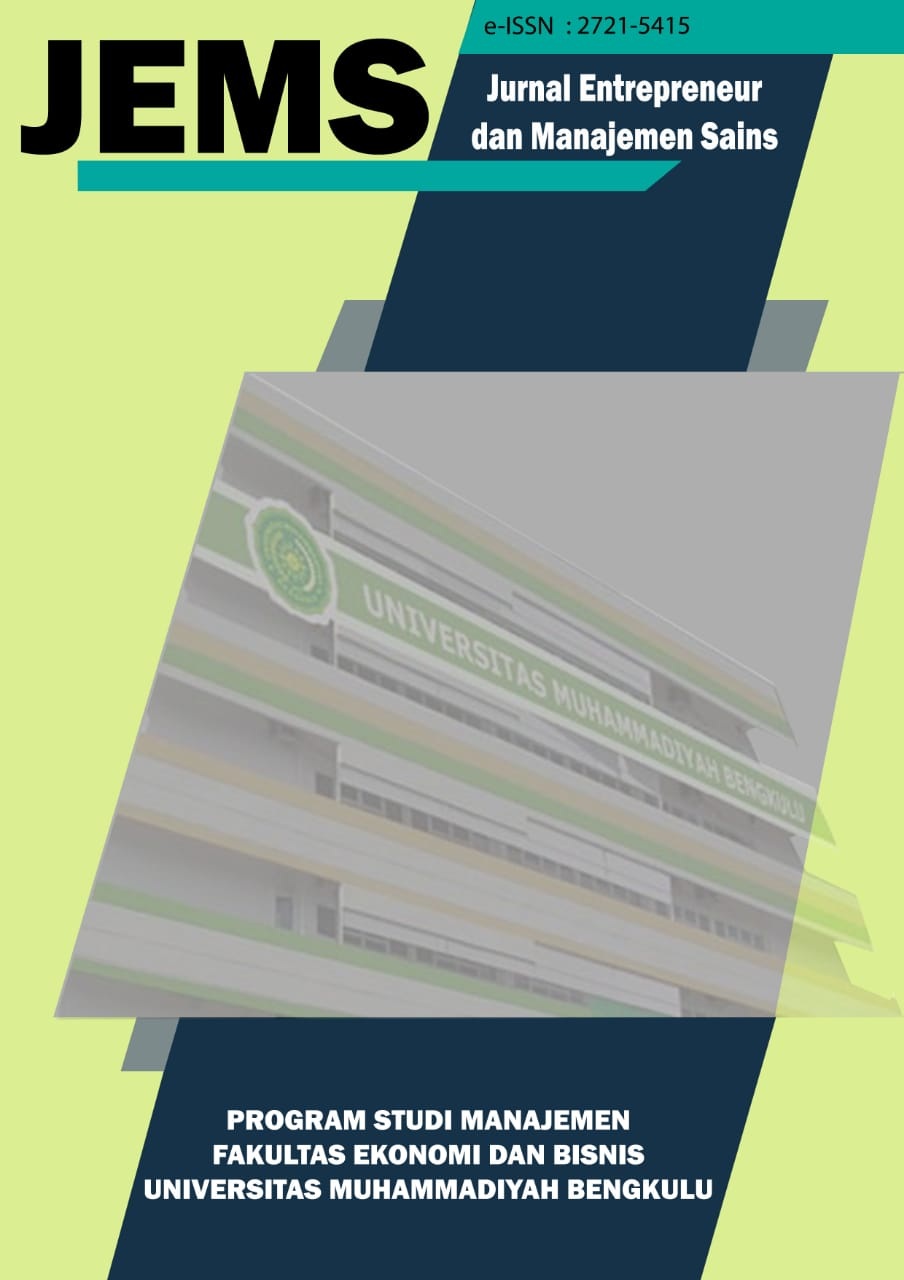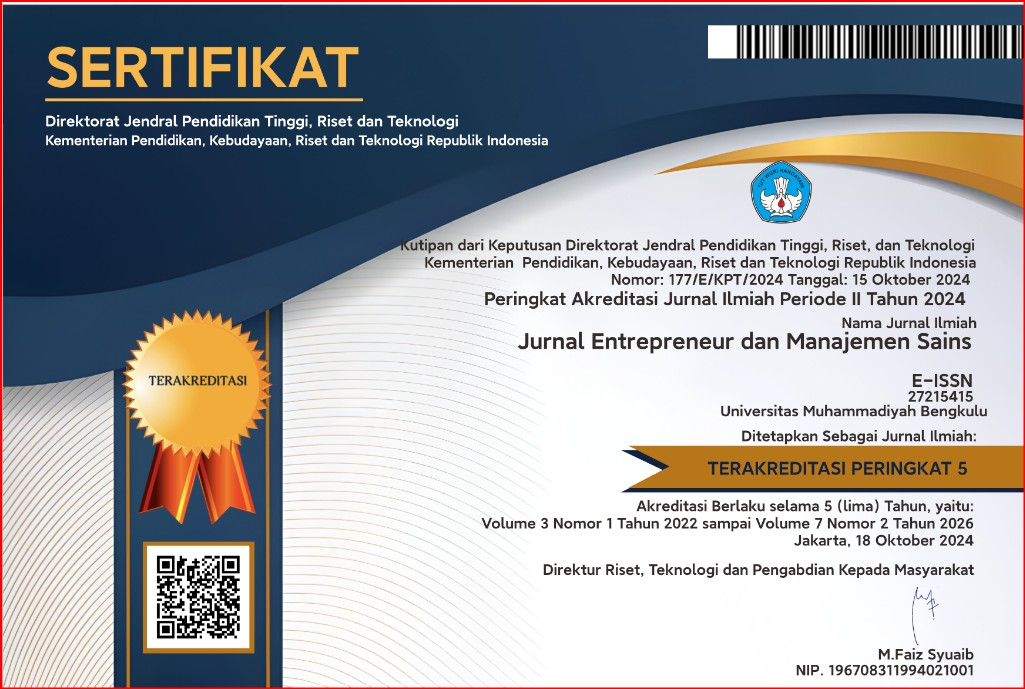ALTERNATIF STRATEGI PEMASARAN PADA BATIK BOGOR TRADISIKU MELALUI QSPM
DOI:
https://doi.org/10.36085/jems.v6i1.7149Abstract
Batik Bogor Tradisiku is one of the batik pioneers in Bogor. This research aims to develop a superior competitive strategy and appropriate business policies for the Batik Bogor Tradisiku business through three stages of analysis methods. The first stage is the input stage, which includes the external factor evaluation matrix (EFE Matrix), competitive profile matrix (CPM), and internal factor evaluation matrix (IFE Matrix). The second stage is the matching stage, consisting of the SWOT and SPACE matrix. The third stage is the decision stage, using a quantitative strategic planning matrix (QSPM). A quadrant 1 position was found through the Input Stage, indicating an aggressive strategy. Furthermore, for the Matching Stage, it is proposed for the SO strategy, namely by developing batik motif designs following developing trends in society, using discount promotion strategies, increasing promotion and marketing through digital media and exhibitions at home and abroad, improving and maintaining the quality of batik products to compete with competitors and maintaining consumer loyalty. Then next, for the Decision Stage through QSPM, it was found that the score for 2 alternative strategies, namely penetrating the market with service development, was 6.60> 6.27, which shows that the right strategy for the Batik Bogor Tradisiku business is to penetrate the market to reach more customers.
Keywords: Management Strategy, QSPM, IFAS-EFAS Matrix, SWOT,
References
Bakshi, A. (n.d.). Gearing Up Small Businesses for Marketing in The Digital Space: An Exploratory Study. https://ssrn.com/abstract=3309290
David, F. (2009). Manajemen Strategis: Konsep (12th ed.). Selemba Empat.
Demiroglu, N. (2021). E-commerce as a tool for the development of small business. SHS Web of Conferences, 106, 01022. https://doi.org/10.1051/shsconf/202110601022
Gao, J., Siddik, A. B., Khawar Abbas, S., Hamayun, M., Masukujjaman, M., & Alam, S. S. (2023). Impact of E-Commerce and Digital Marketing Adoption on the Financial and Sustainability Performance of MSMEs during the COVID-19 Pandemic: An Empirical Study. Sustainability (Switzerland), 15(2). https://doi.org/10.3390/su15021594
Hery. (2018). Manajemen Strategik. In Manajemen Strategik.
Hidayattuloh, T., Herdyan, D., Arga Felani, D., Fatimah, S., Hadi Supratikta, dan, & Pascasarjana Universitas Pamulang, P. (2023). Analisis Strategi Dengan Metode SWOT Dan QSPM (Quantitative Strategic Planning Matrix) Studi Kasus: Lampu Merah Coffee Shop Payakumbuh. Management and Science Proceedings), 3(2), 872–877. http://www.openjournal.unpam.ac.id/index.php/SNH
Kasemsap, K. (2016). Implementing Electronic Commerce in Global Marketing. , 591-602. https://doi.org/10.4018/978-1-4666-9787-4.CH043.
Kuester, S., Konya-Baumbach, E., & Schuhmacher, M. C. (2018). Get the show on the road: Go-to-market strategies for e-innovations of start-ups. Journal of Business Research, 83, 65–81. https://doi.org/10.1016/J.JBUSRES.2017.09.037
Kuncoro, M. (2003). Metode Riset untuk Bisnis & Ekonomi. Erlangga.
Kung, M. T., & Zhang, Y. (2011). Creating competitive markets for small businesses with new media and E-business strategy. In International Journal of e-Business Research (Vol. 7, Issue 4, pp. 31–49). https://doi.org/10.4018/jebr.2011100103
Mazzarol, T. (2015). SMEs engagement with e-commerce, e-business and e-marketing. Small Enterprise Research, 22(1), 79–90. https://doi.org/10.1080/13215906.2015.1018400
Nyimas Ekinevita, P., Retno, Astuti., & Shyntia Atica, P. (2014). Perencanaan Strategi Pengembangan Restoran Menggunakan Analisis Swot Dan Metode QSPM (Quantitative Strategic Planning Matriks) (Studi Kasus Restoran Big Burger Malang). Industria: Jurnal Teknologi Dan Manajemen Agroindustri, 3(2), 93106.
Qanita, A. (2020). Analisis Strategi dengan Metode Swot dan Qspm (Quantitative Strategic Planning Matrix): Studi Kasus Pada D’Gruz Caffe Di Kecamatan Bluto Sumenep. Komitmen: Jurnal Ilmiah Manajemen, 1(2), 11–24. https://doi.org/10.15575/jim.v1i2.10309
Rosário, A., & Raimundo, R. (2021). Consumer marketing strategy and e-commerce in the last decade: A literature review. In Journal of Theoretical and Applied Electronic Commerce Research (Vol. 16, Issue 7, pp. 3003–3024). MDPI. https://doi.org/10.3390/jtaer16070164
Safitri, E. (2018). Penggunaan Quantitative Strategic Planning Matrix (QSPM) Untuk Penentuan Alternatif Strategi Prioritas Bisnis Tapis (Studi Pada UMKM Tapis Ruwa Jurai Bandar Lampung). Skripsi, Universitas Lampung, Bandar Lampung.
Santoso, S. (2013). Statistik Ekonomi Plus Aplikasi SPSS. Umpo Press.
Situmorang, S. H., & Luthfi, M. (2012). Analisis Data: Untuk Riset Manajemen dan Bisnis. USU Press.
Yunus, E. (2016). Manajemen Strategis. Andi.
Downloads
Published
Issue
Section
License

This work is licensed under a Creative Commons Attribution-NonCommercial-NoDerivatives 4.0 International License.







